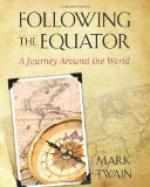The chameleon in the hotel court. He is fat and indolent and contemplative; but is business-like and capable when a fly comes about —reaches out a tongue like a teaspoon and takes him in. He gums his tongue first. He is always pious, in his looks. And pious and thankful both, when Providence or one of us sends him a fly. He has a froggy head, and a back like a new grave—for shape; and hands like a bird’s toes that have been frostbitten. But his eyes are his exhibition feature. A couple of skinny cones project from the sides of his head, with a wee shiny bead of an eye set in the apex of each; and these cones turn bodily like pivot-guns and point every-which-way, and they are independent of each other; each has its own exclusive machinery. When I am behind him and C. in front of him, he whirls one eye rearwards and the other forwards—which gives him a most Congressional expression (one eye on the constituency and one on the swag); and then if something happens above and below him he shoots out one eye upward like a telescope and the other downward—and this changes his expression, but does not improve it.
Natives must not be out after the curfew bell without a pass. In Natal there are ten blacks to one white.
Sturdy plump creatures are the women. They comb their wool up to a peak and keep it in position by stiffening it with brown-red clay—half of this tower colored, denotes engagement; the whole of it colored denotes marriage.
None but heathen Zulus on the police; Christian ones not allowed.
May 9. A drive yesterday with friends over the Berea. Very fine roads and lofty, overlooking the whole town, the harbor, and the sea-beautiful views. Residences all along, set in the midst of green lawns with shrubs and generally one or two intensely red outbursts of poinsettia—the flaming splotch of blinding red a stunning contrast with the world of surrounding green. The cactus tree—candelabrum-like; and one twisted like gray writhing serpents. The “flat-crown” (should be flat-roof) —half a dozen naked branches full of elbows, slant upward like artificial supports, and fling a roof of delicate foliage out in a horizontal platform as flat as a floor; and you look up through this thin floor as through a green cobweb or veil. The branches are japanesich. All about you is a bewildering variety of unfamiliar and beautiful trees; one sort wonderfully dense foliage and very dark green—so dark that you notice it at once, notwithstanding there are so many orange trees. The “flamboyant”—not in flower, now, but when in flower lives up to its name, we are told. Another tree with a lovely upright tassel scattered among its rich greenery, red and glowing as a firecoal. Here and there a gum-tree; half a dozen lofty Norfolk Island pines lifting their fronded arms skyward. Groups of tall bamboo.
Saw one bird. Not many birds here, and they have no music—and the flowers not much smell, they grow so fast.




